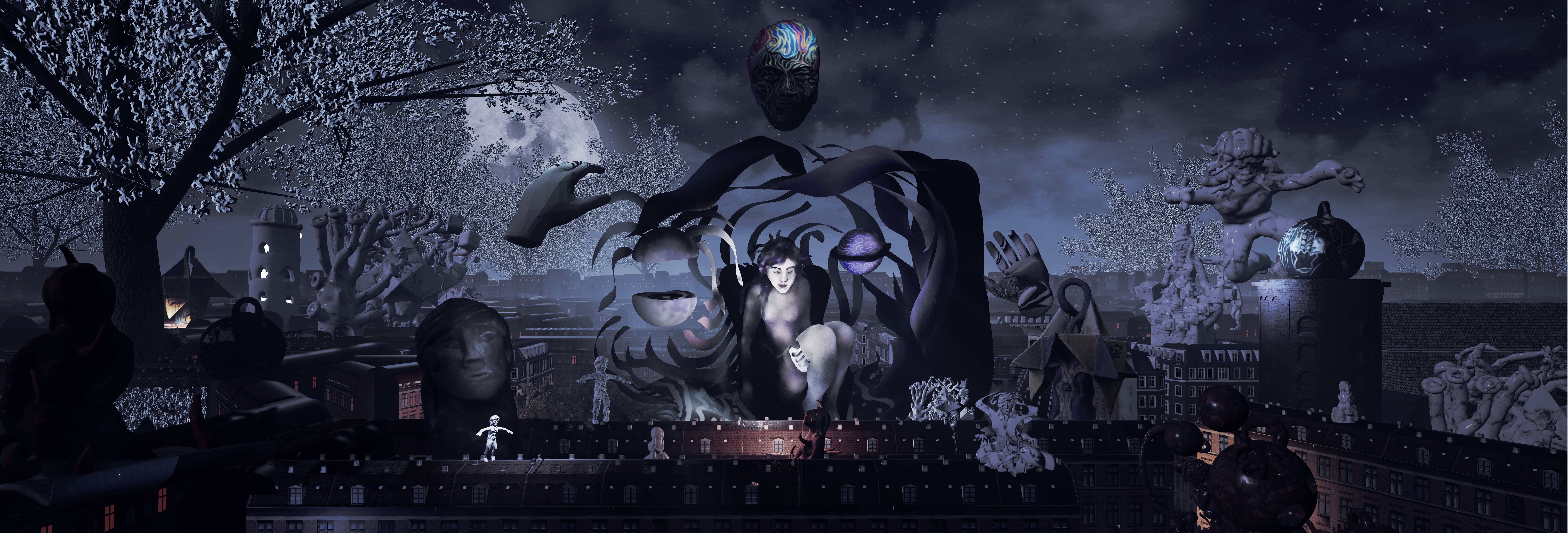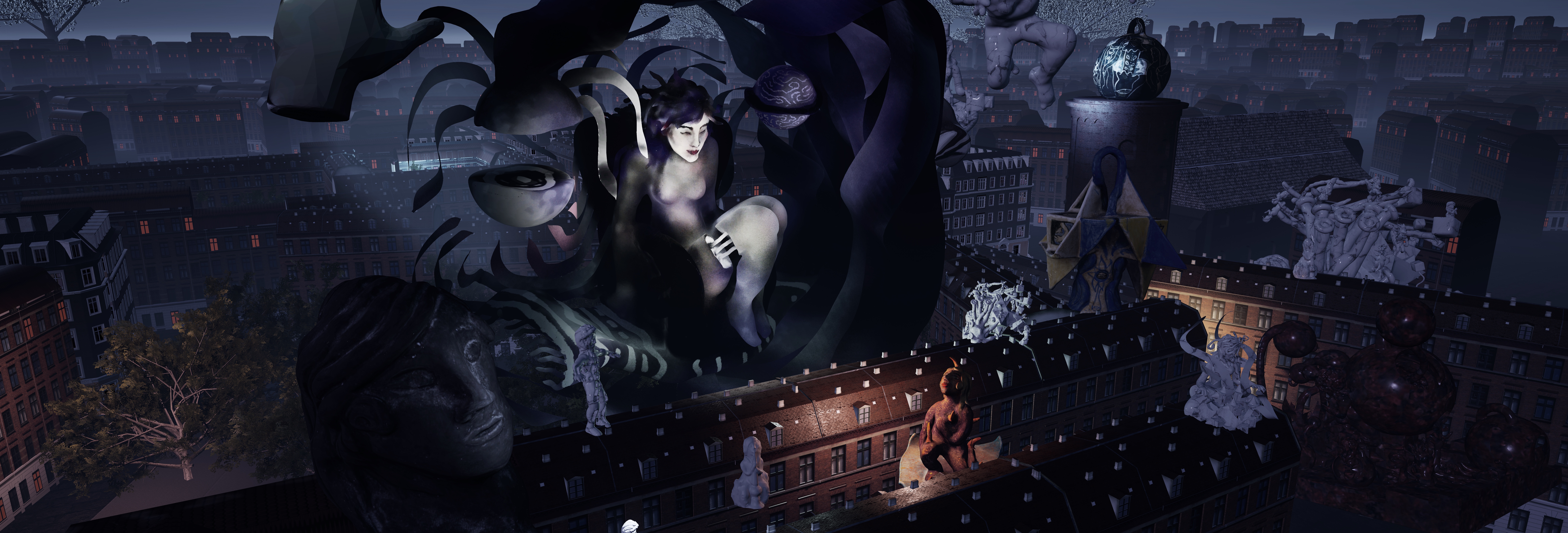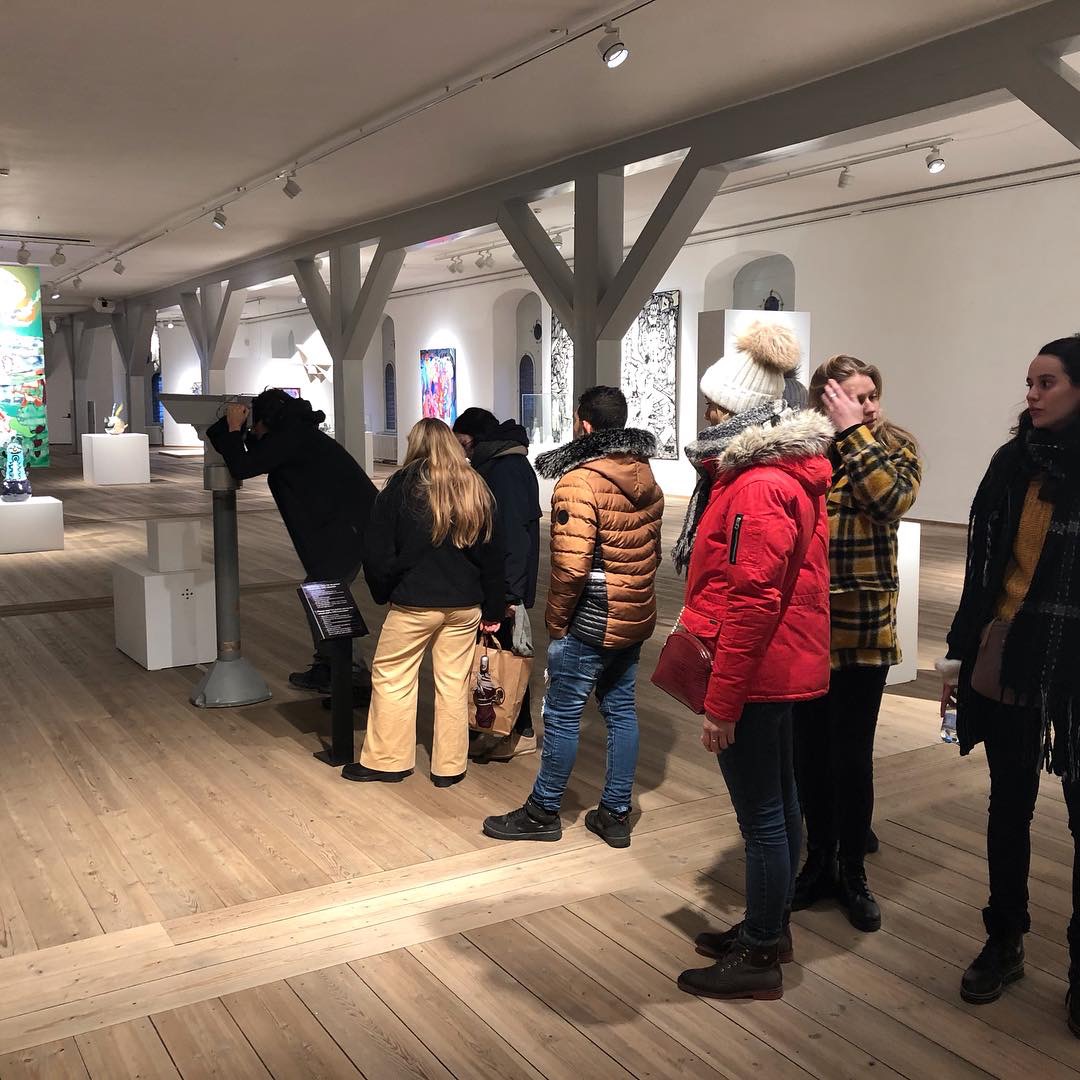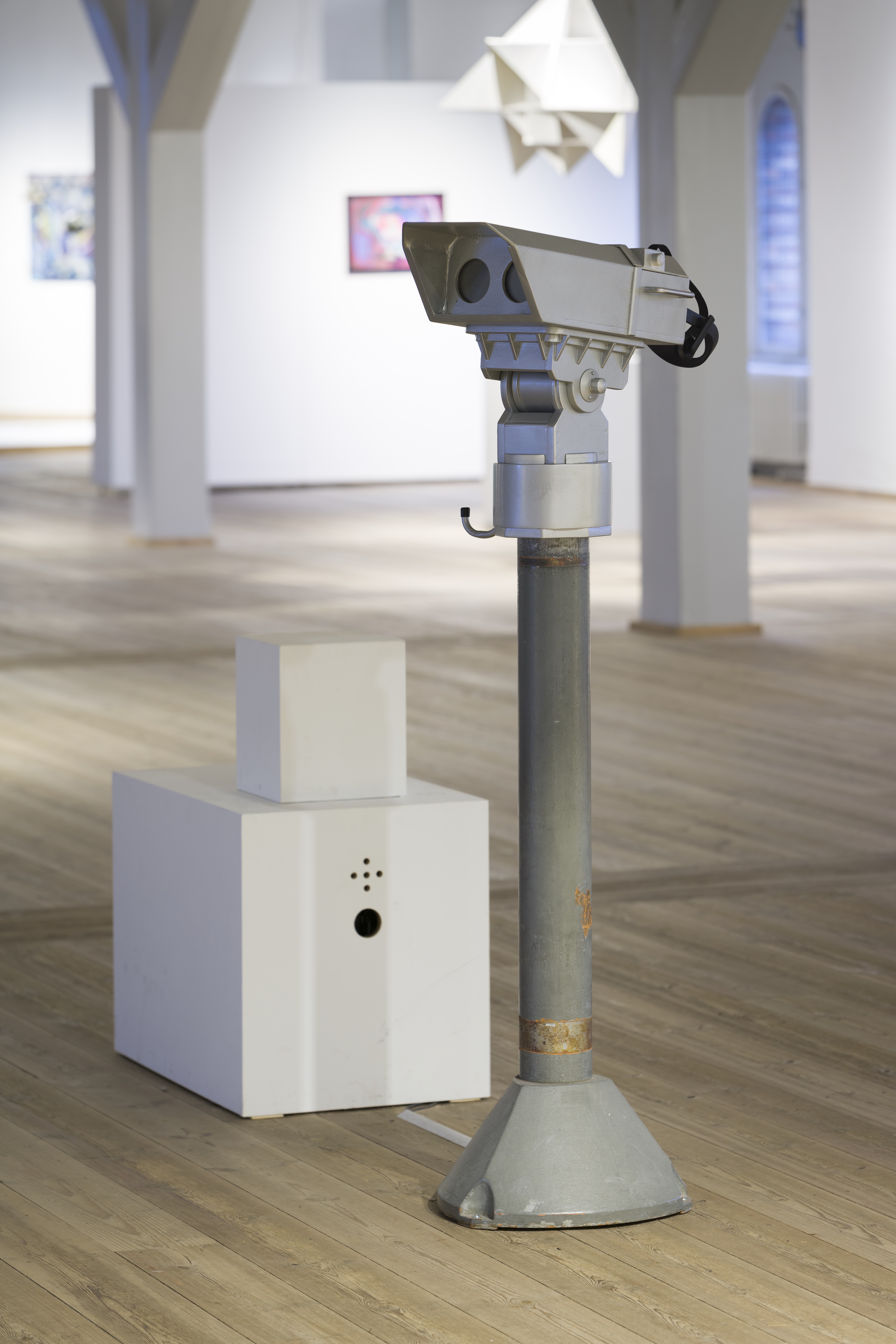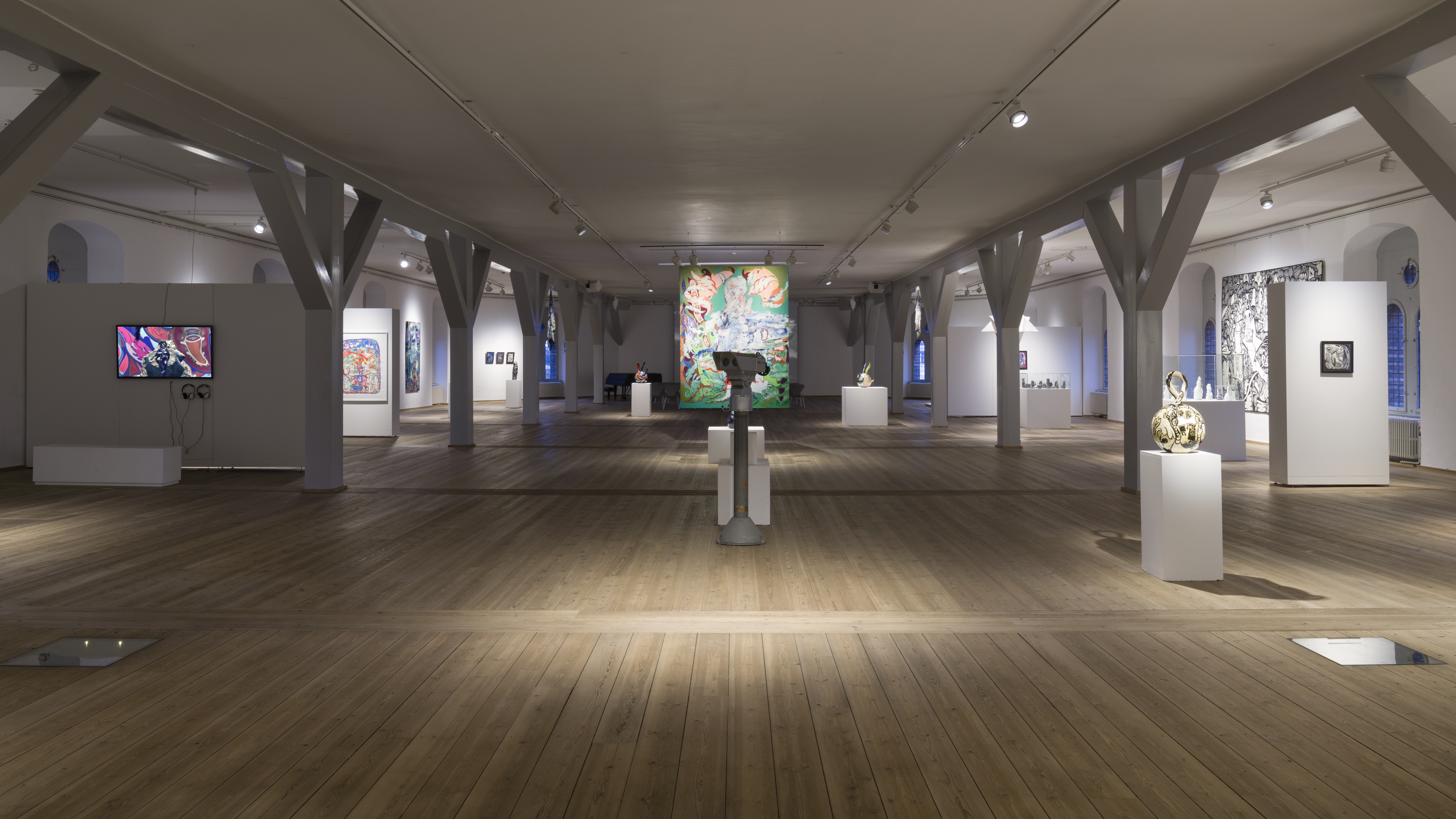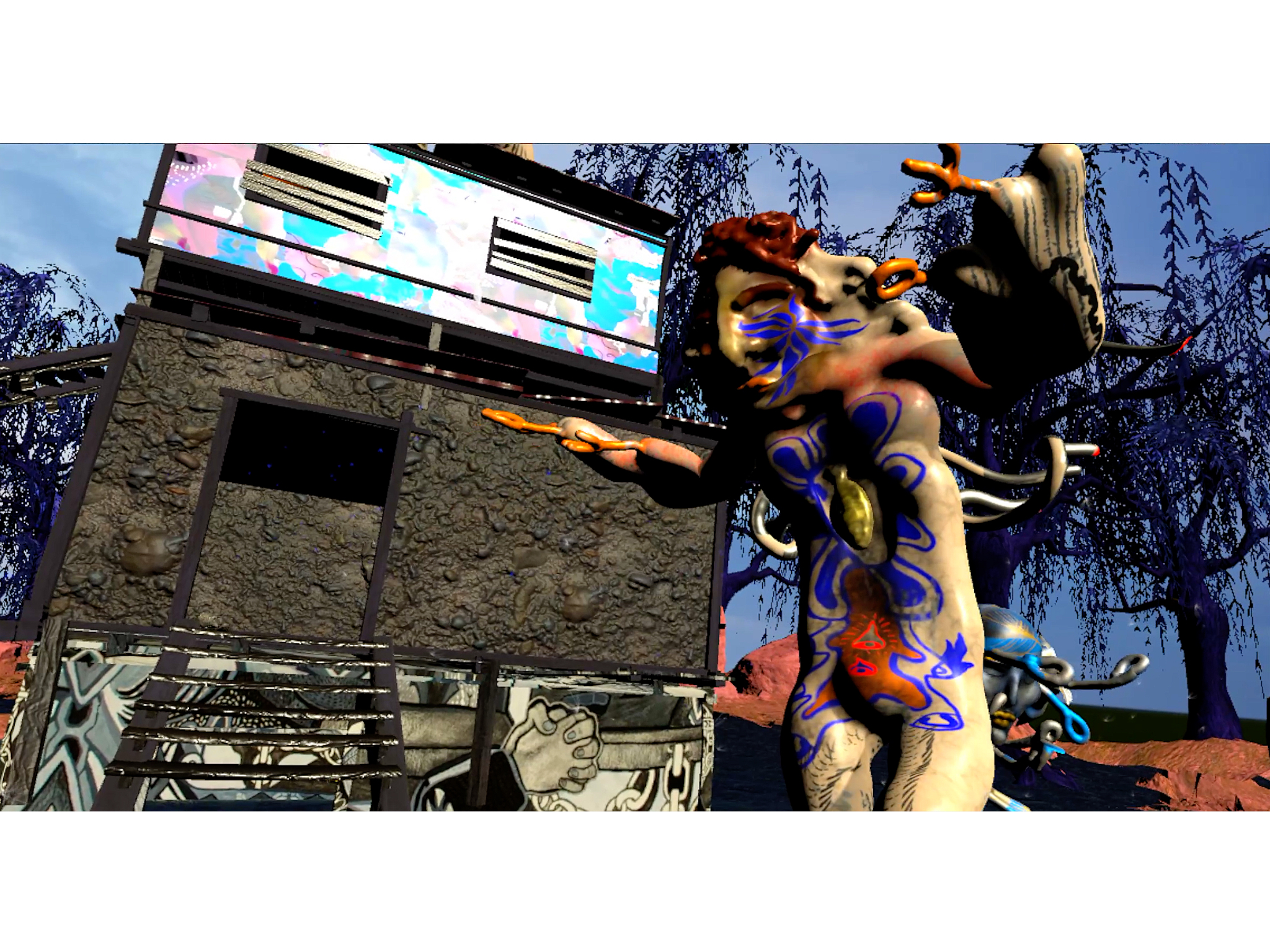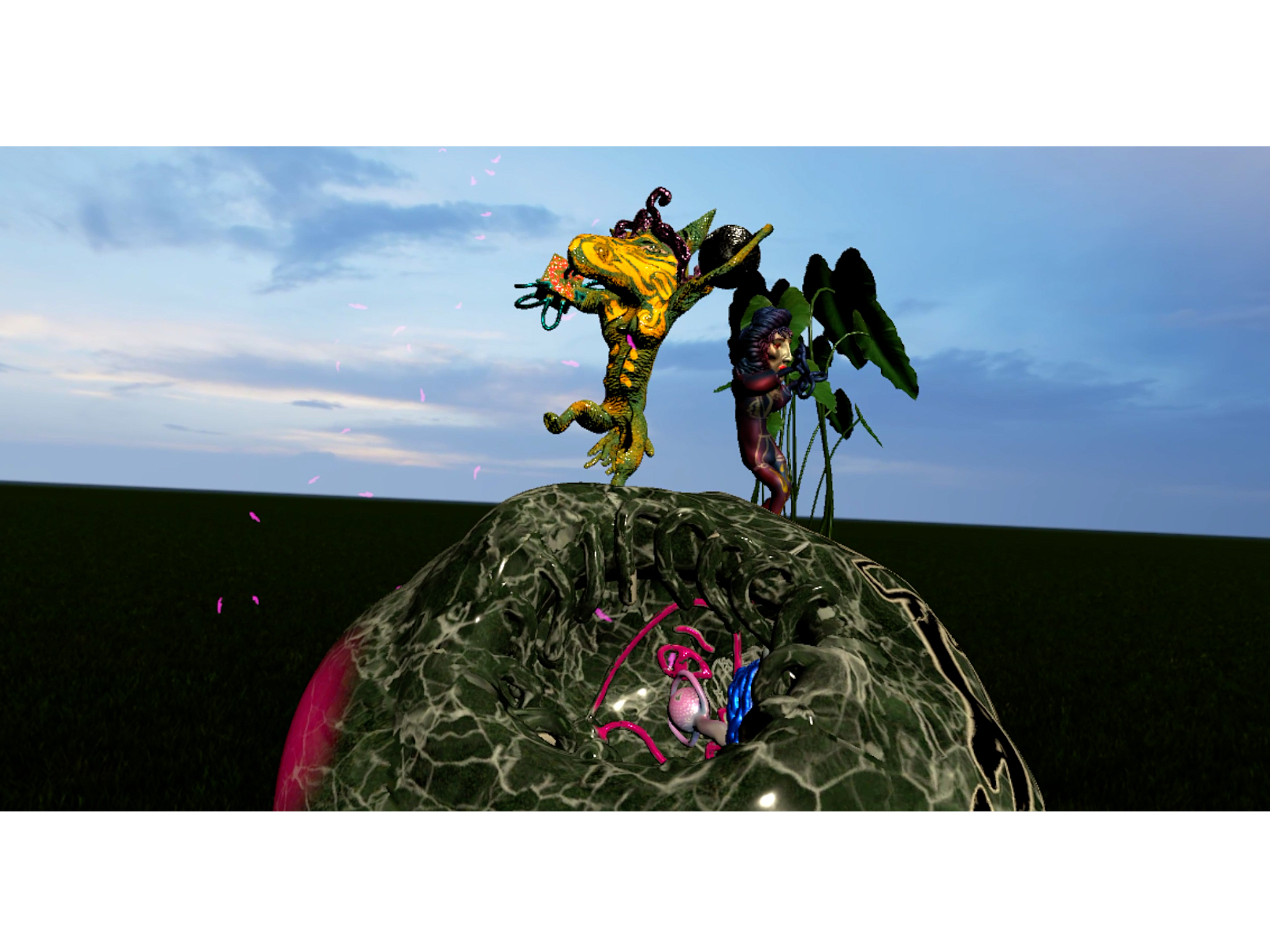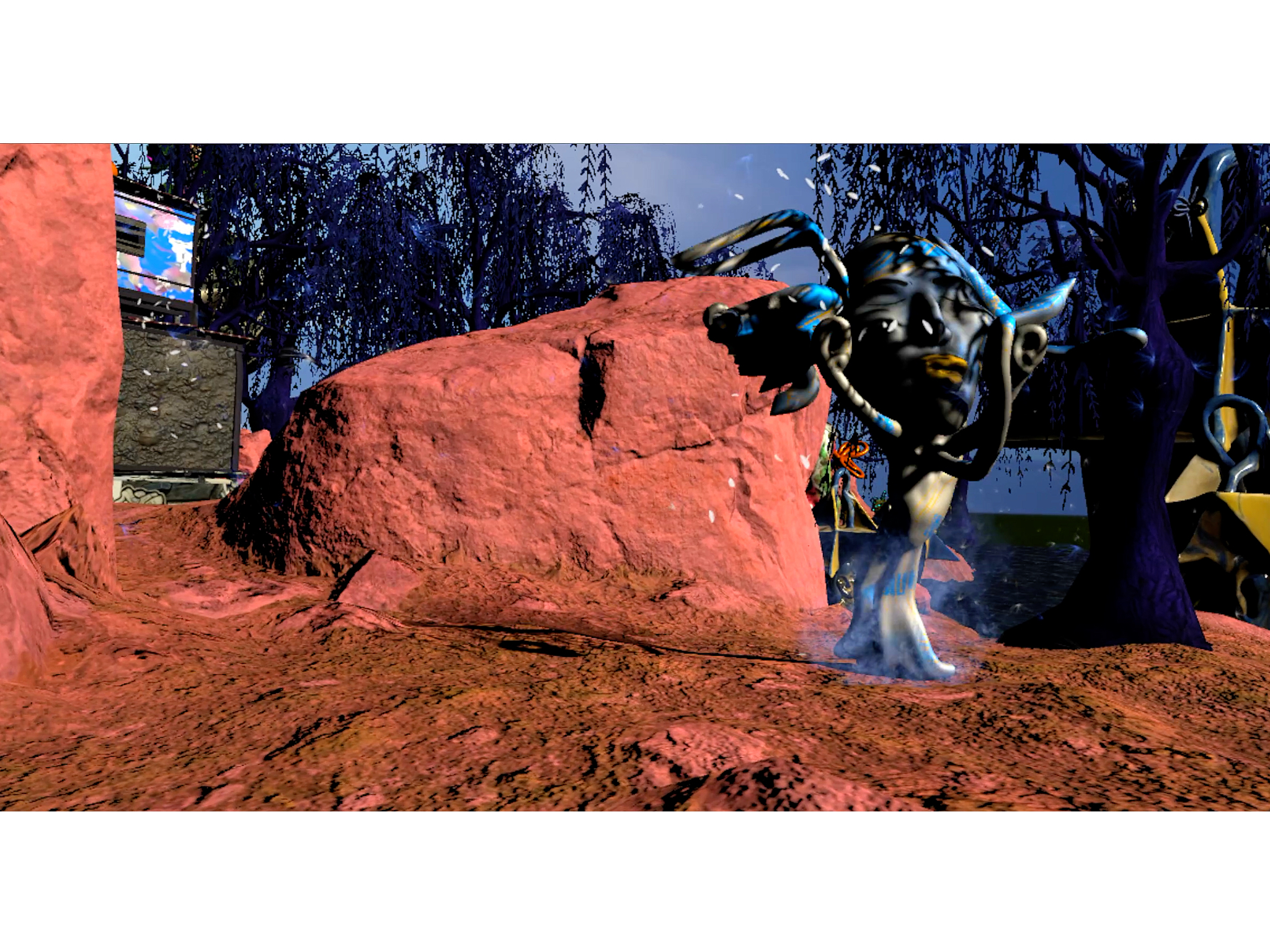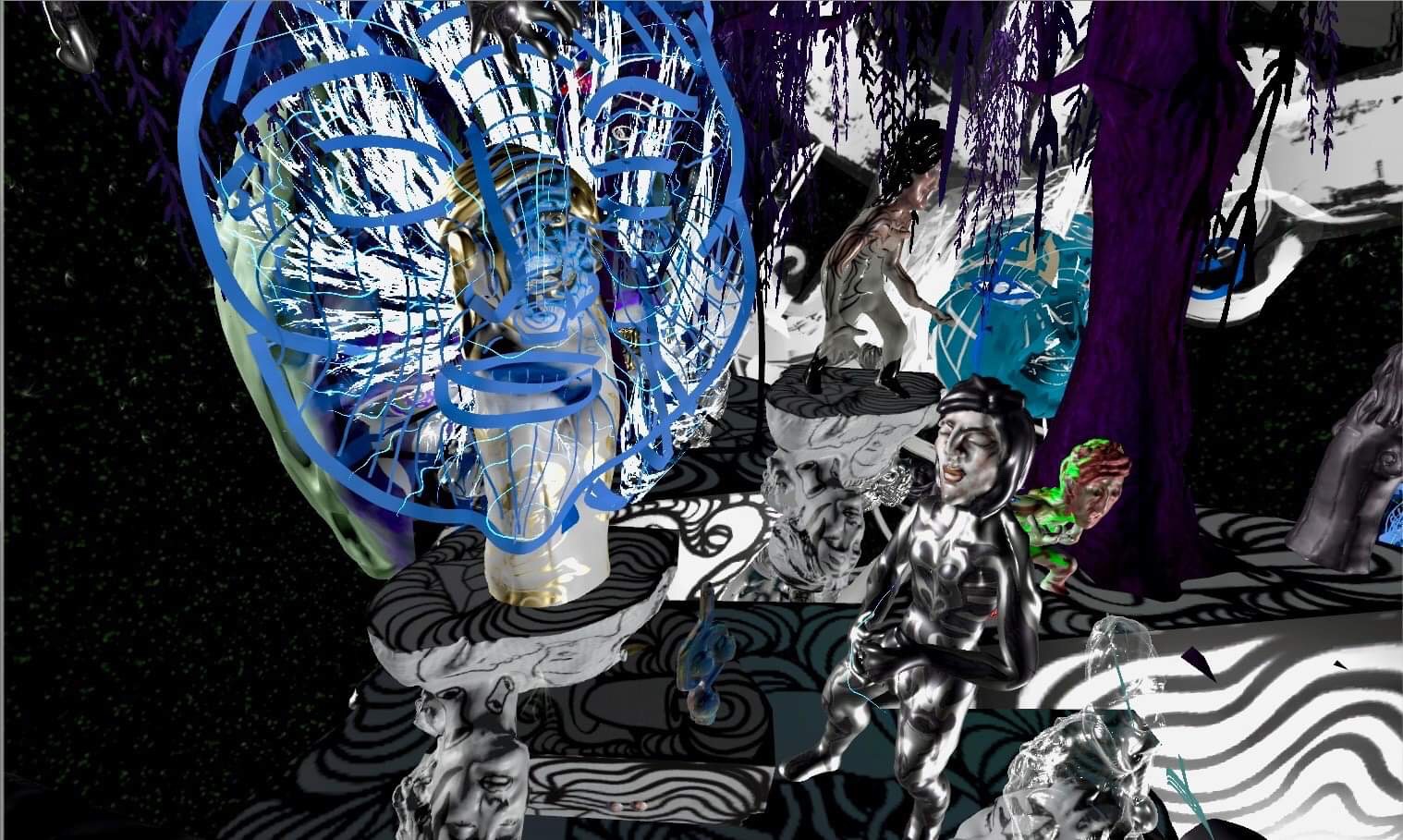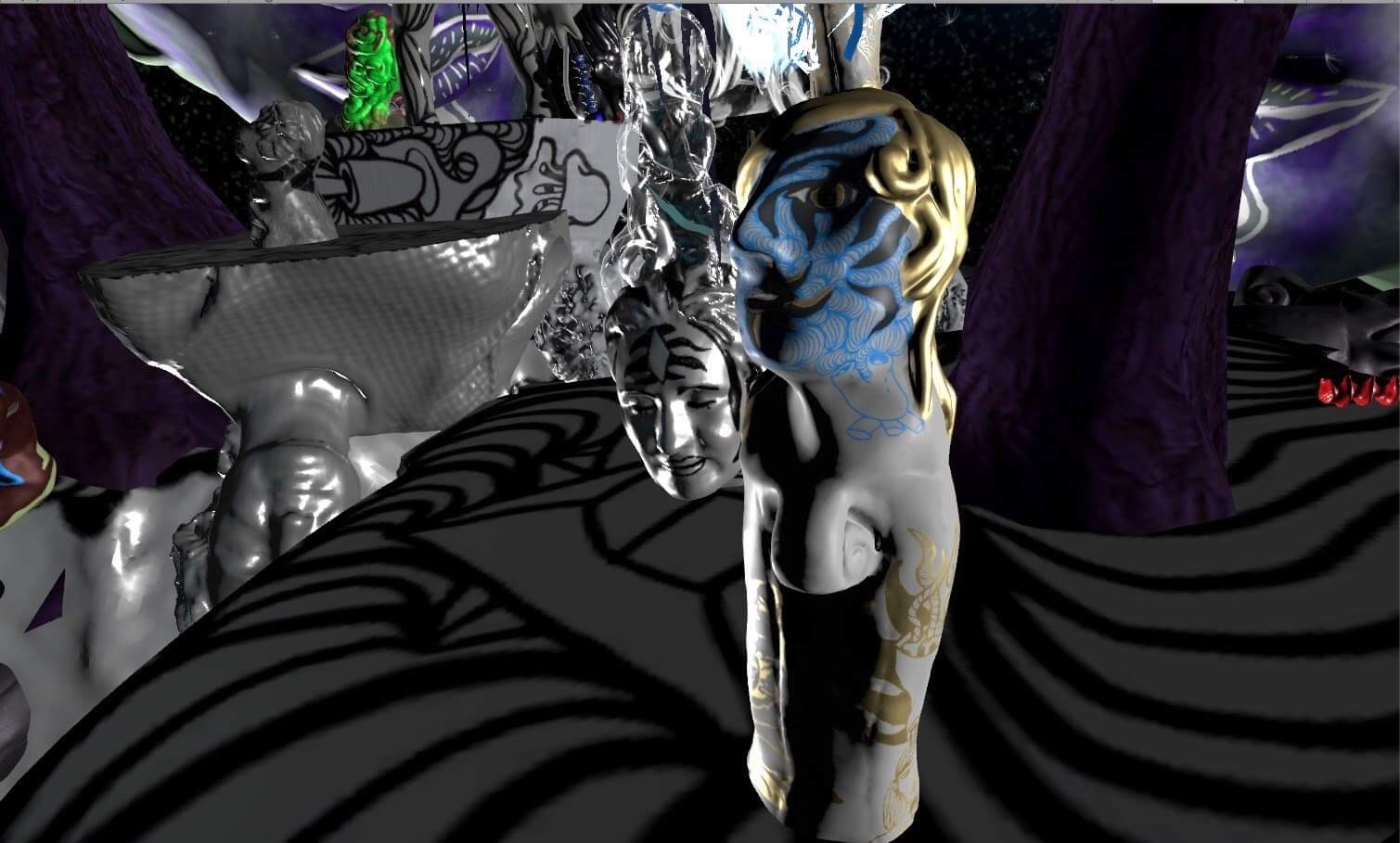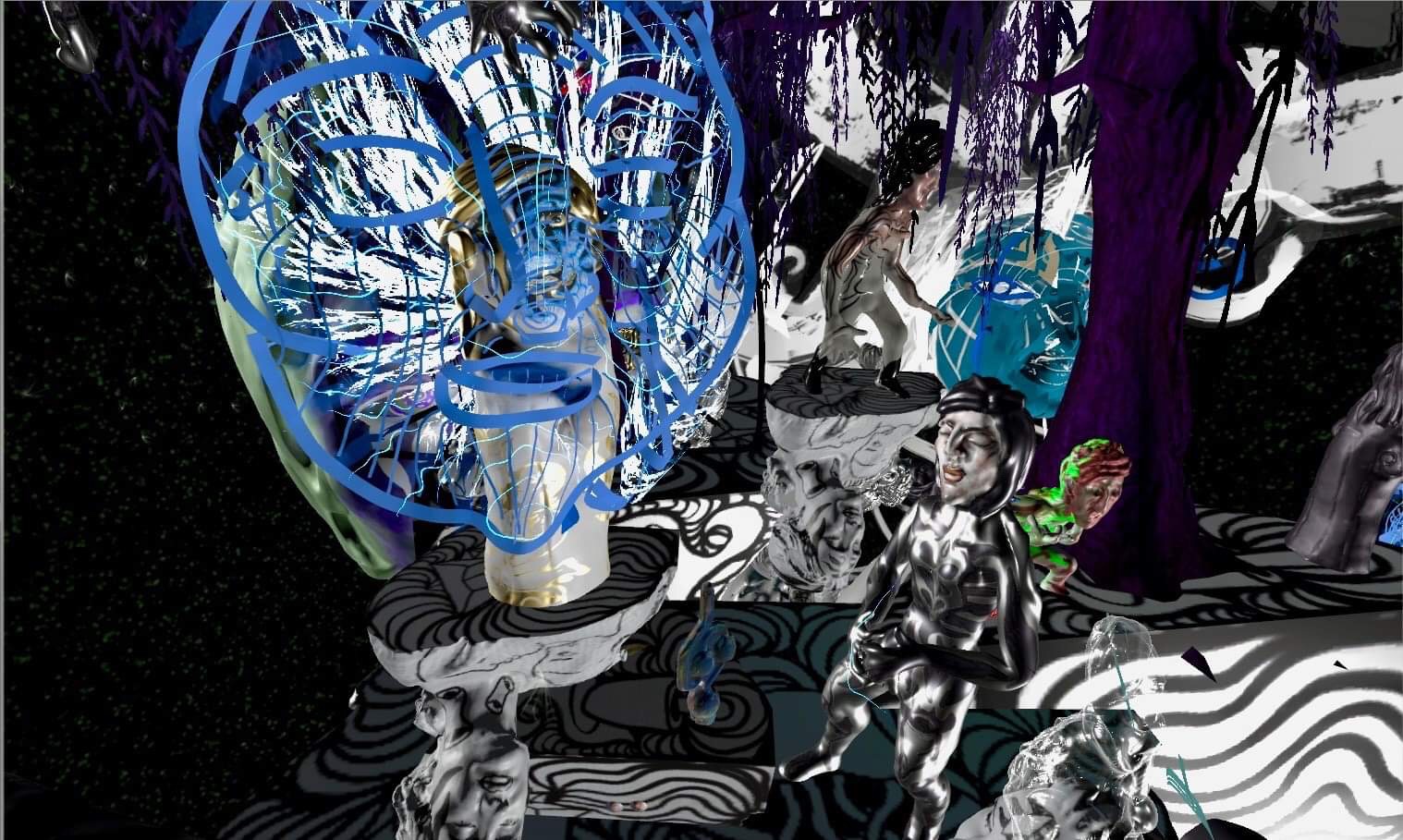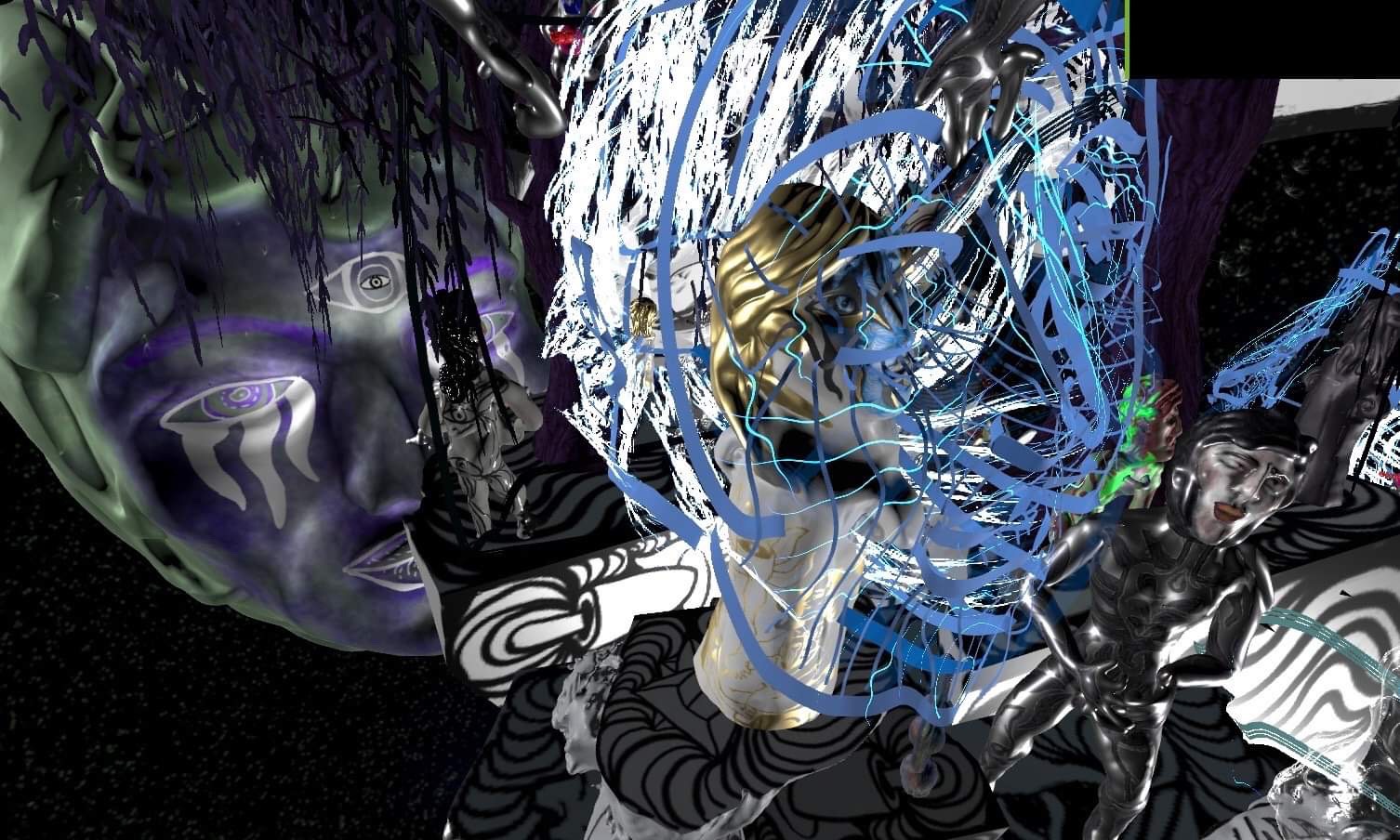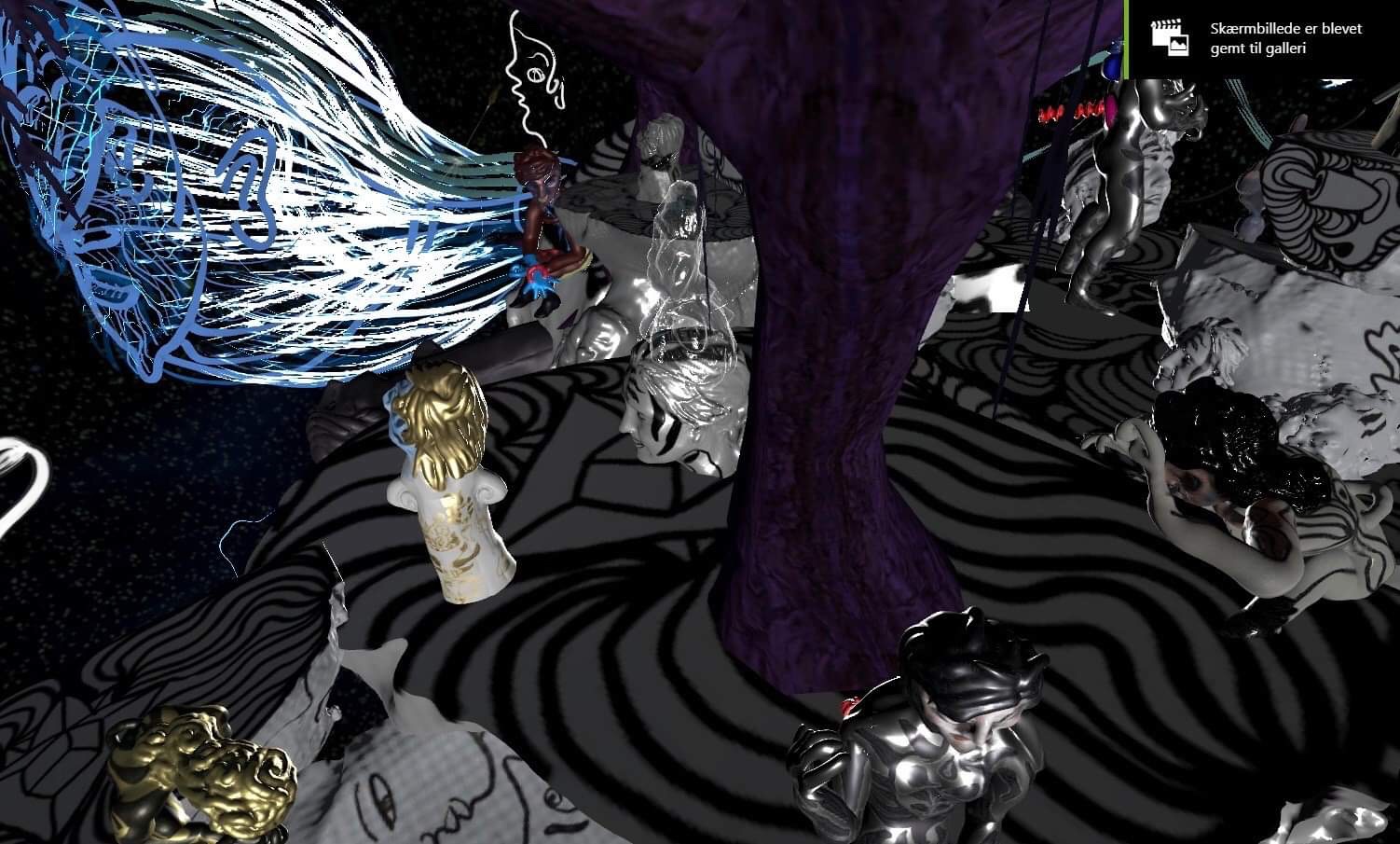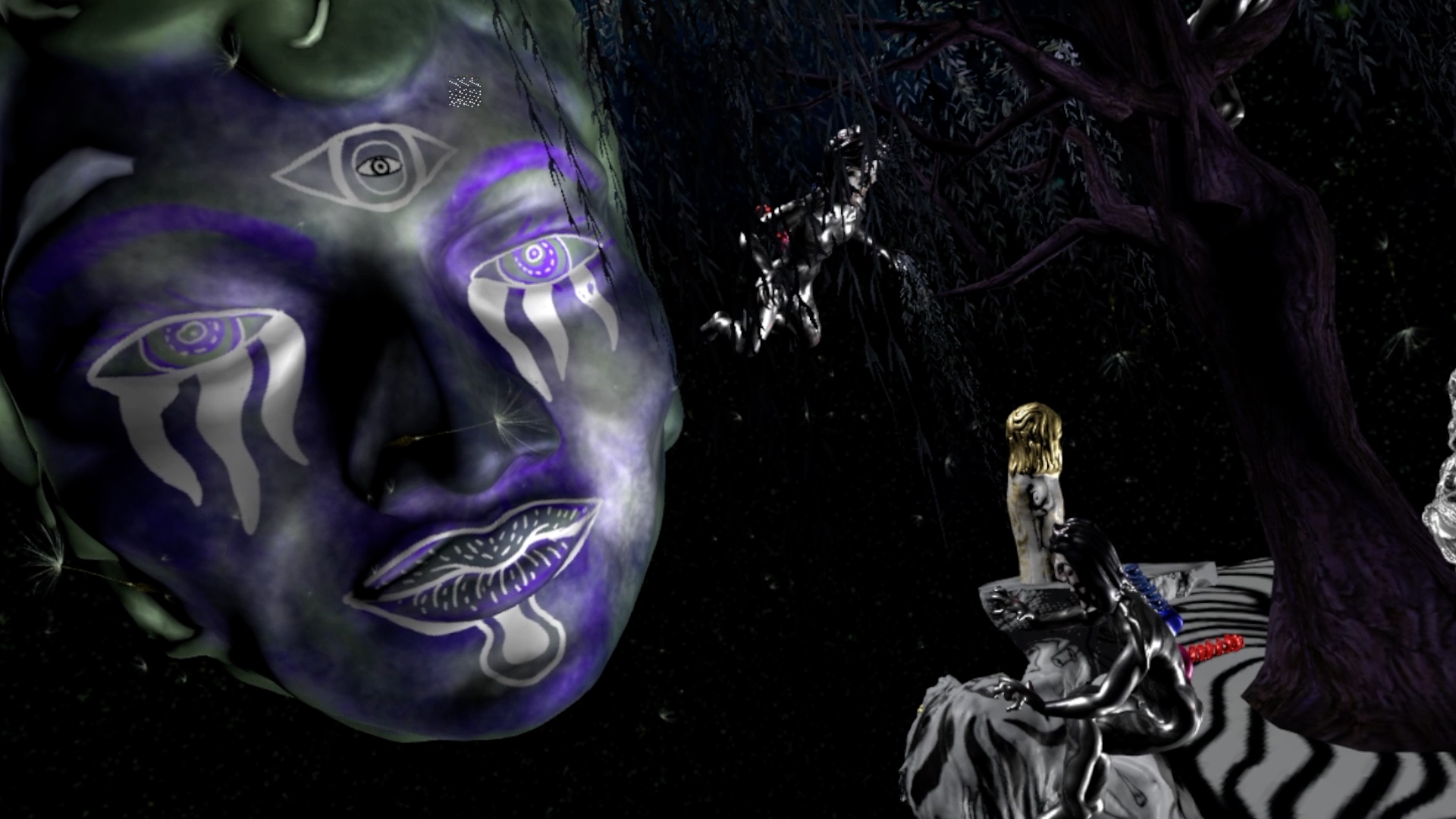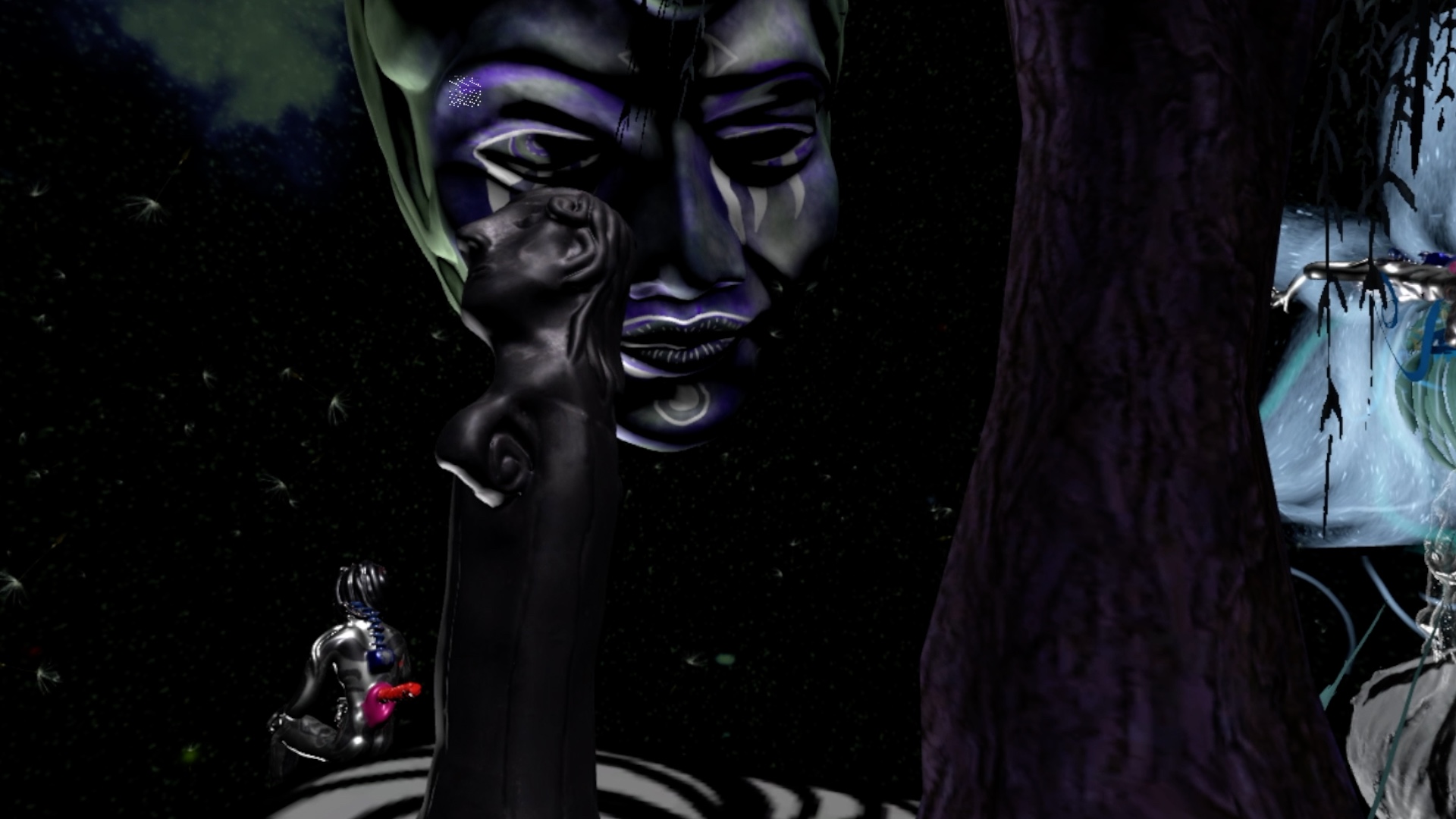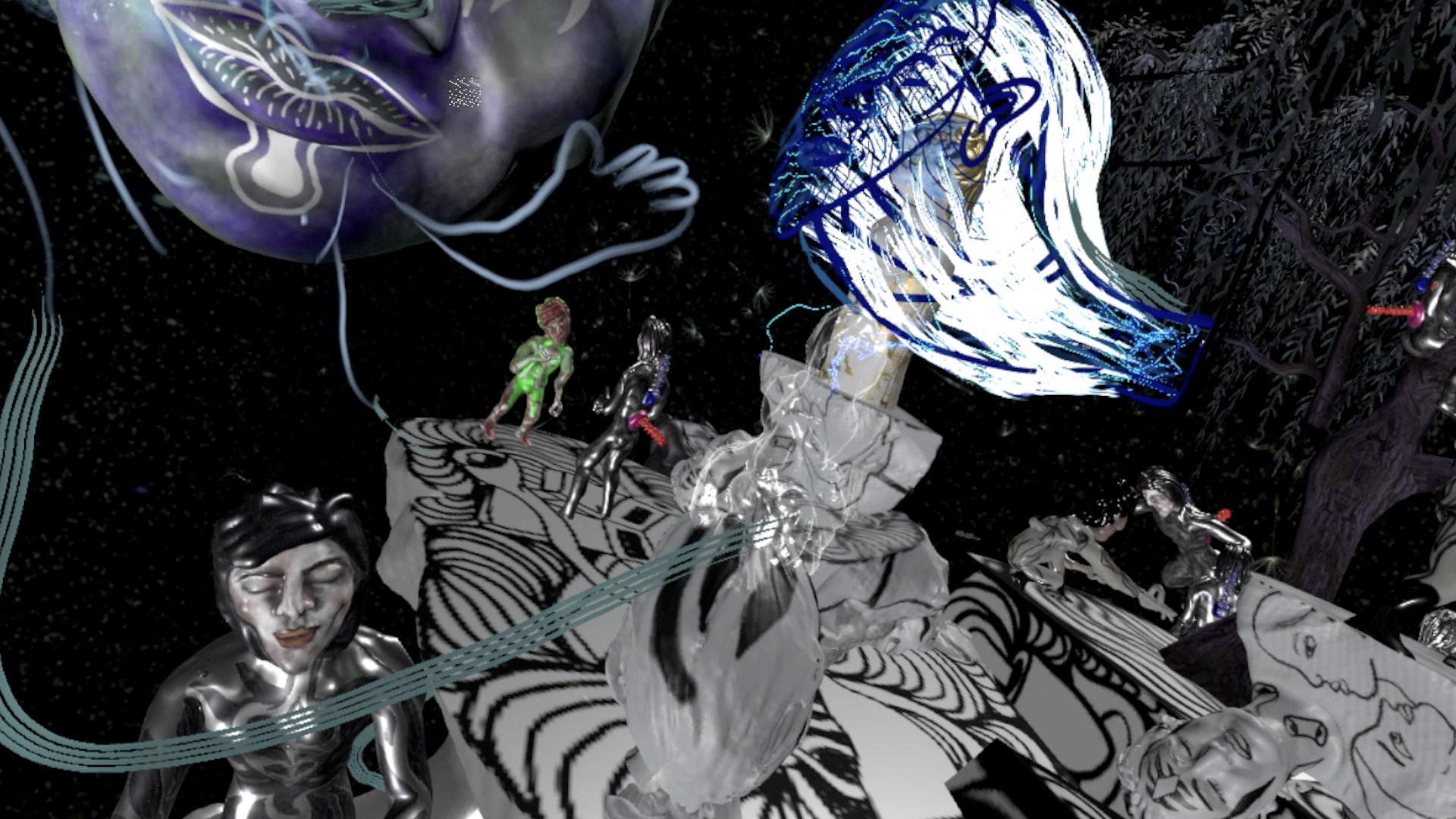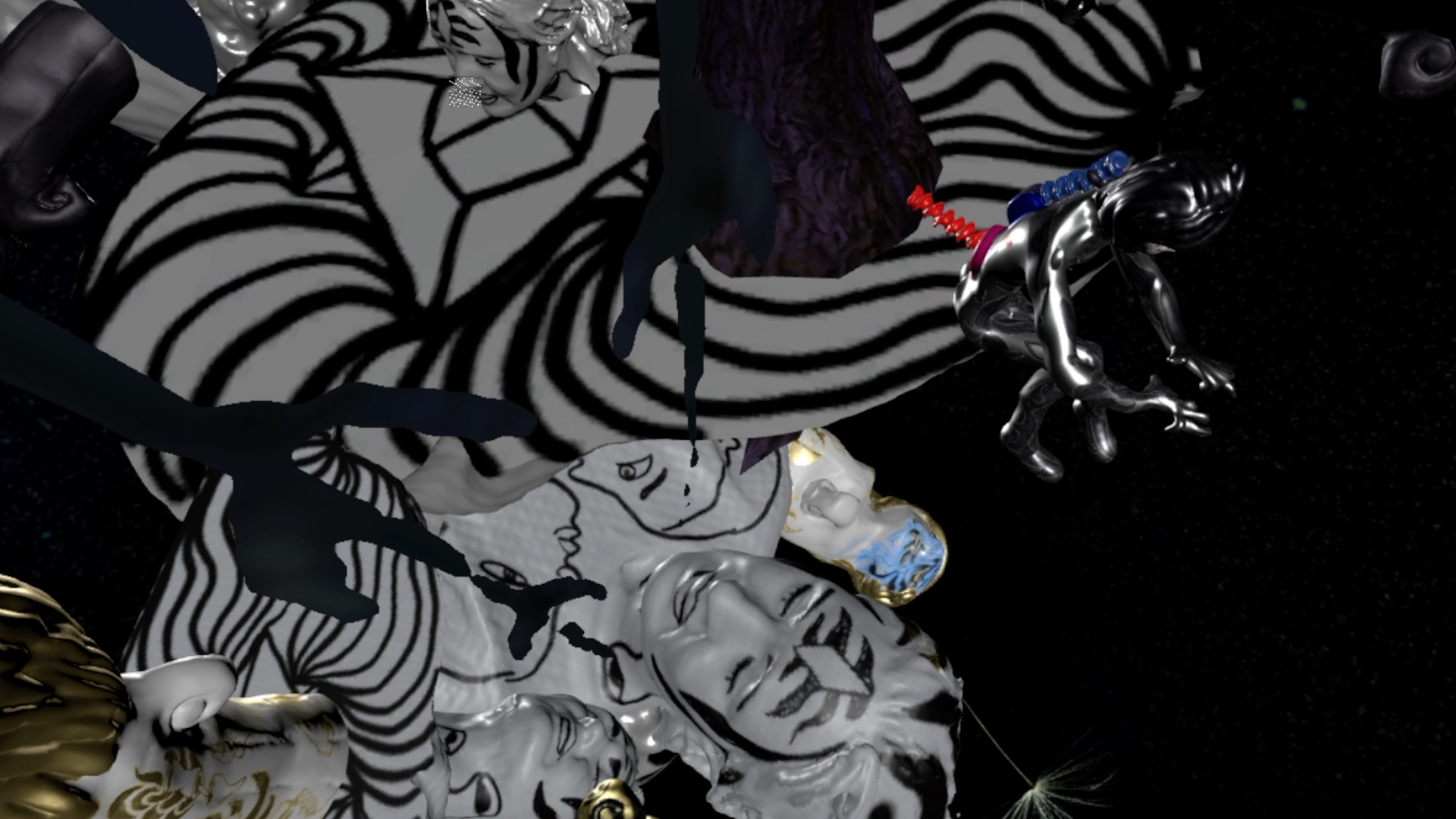ARoS Museum & Radar Contemporary
DEMOS 2021
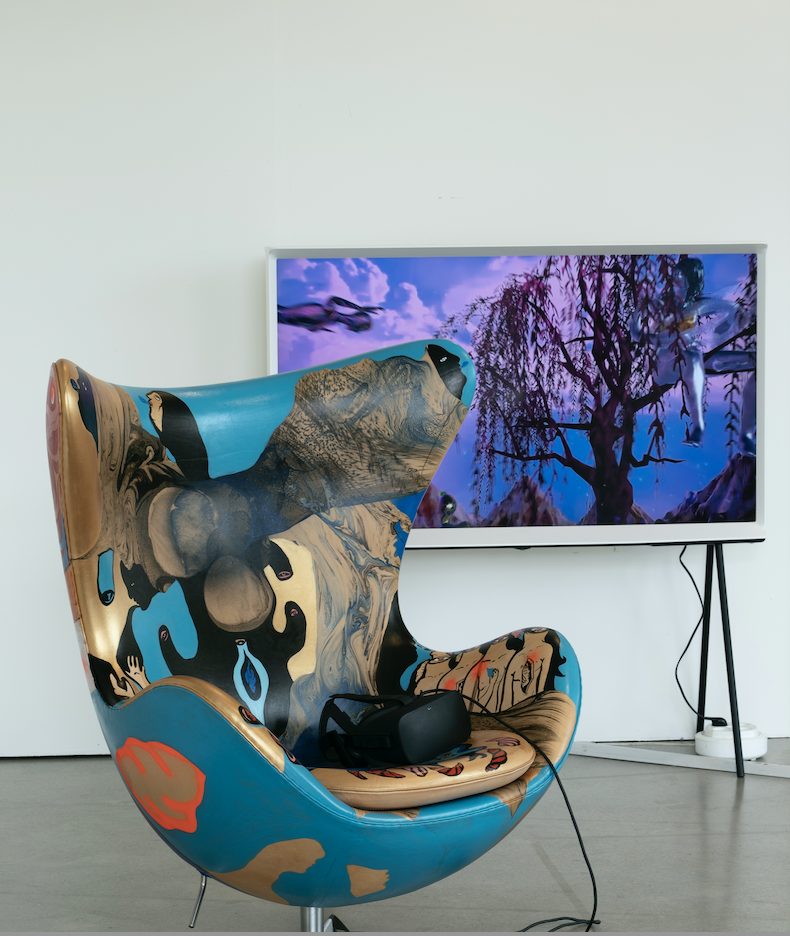
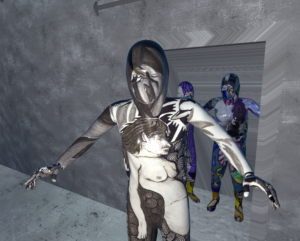
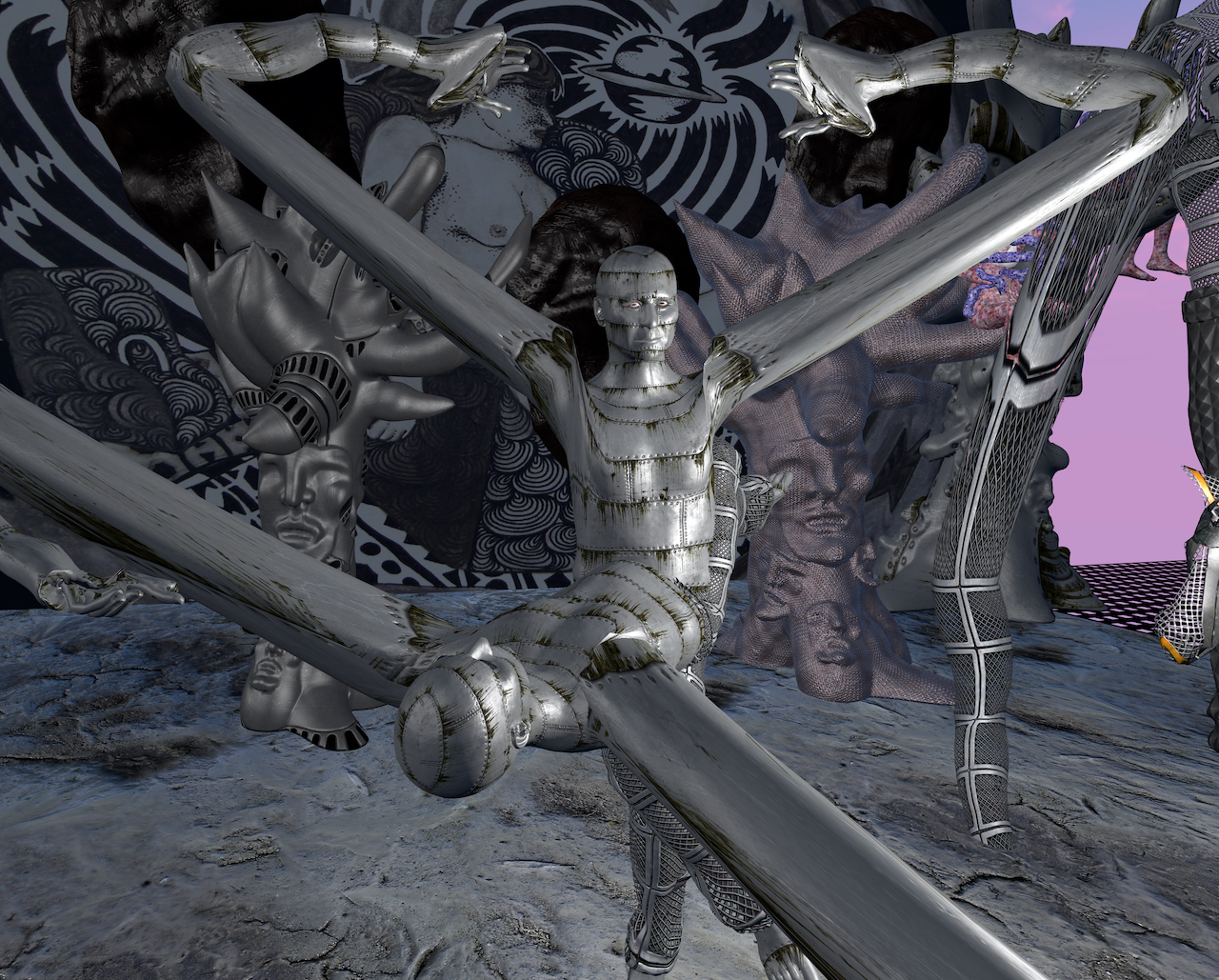
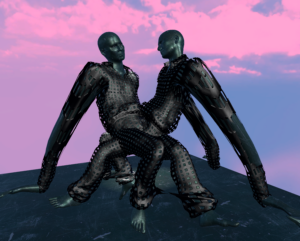
The word ‘demos’ refers to the ruling body of citizens in ancient Athens, the first Internet service provider in the USSR, and the small programs and audiovisual presentations produced by people from the computer art subculture ‘demo scene’ to show off their skills. As if we were to embark on one of this subculture’s demo parties, we immerseourselves into a digital primordial soup in Ida Kvetny’s work DEMOS, passing spiked bodies, cyborgs, and chimeras with contorted limbs. Rigged and glitched, they make us aware of the metallic technology taking over our reality while hands reaching out from the wall remind us how all worlds are created and, thus, possible to remake.
By hacking reality’s software, Kvetny’s work presents a demo of how the world might look. To do so, she uses world-building known from fantasy literature and game design where archetypes are reused across the various universes. Marcel Duchamp’s Fountain (1917) is repeated in Kvetny’s world, referencing Elsa von Freitag – the actual inventor of this game-changing work. Thereby, as a punk reminder of other forgotten female inventors, the work questions the archetype of the male engineer invented after World War II.
Ida Schyum,
cand.mag in art histor
Text : Ida Schyum
cand.mag in art history
PLATFORM
HTC Vive, Oculus Rift, Oculus Quest
Duration
6 min
Credits:
Made in Unity/ Music Final Cut effects
Lithodendrum 2020
“A hallucinogenic vibe is imminent in Ida Kvetny’s Virtual Reality (VR) work Lithodendrum. Dancing figurines and deep techno grottoes make up for all the closed adventure parks and shopping malls during the corona quarantine. The viewer is delegated to experience this grotesque multi-sensory inferno. Kvetny’s work is the party we need to immerse ourselves into these times. Definitely, you could party in here for days, drifting away into a subconscious cosmography of Medusa-like avatars on saturated coral red cliffs with deep blue trees swaying in the wind. Like Neverland, it only exists if you believe in it, but is it the future? Kvetny’s reckless visual language and color fetichism makes this escapist experience close to an overdose, and thus, the work ends up questioning the very nature of VR: What kind of Disneyland are we immersing ourselves into, when the body’s capability of new sensations has become a crucial resource for contemporary forms of capitalism in digital creative industries?
Text : Ida Schyum
cand.mag in art history
PLATFORM
HTC Vive, Oculus Rift, Oculus Quest
Duration
6 min
Made in Unity/ Music Final Cut effects
“Lithodendrum” is a cohesive installation comprising a 360-degree VR multi-sensory experience space. The work is founded in the nature philosopher Schelling’s perception of the universe as one big organism. Taking inspiration from the quotation: “the spirit sleeps in the rock, dreams in the plant, awakens in the animal and become conscious in Man”, a multimodal inner landscape is created where the body dissolves and the viewer flows above a rippling sea of colours and over a romantic landscape of coral red cliffs and deep blue trees swaying in the wind.
The universe is peopled by Medusa-like organisms moving restlessly in the landscape of 3D scanned ceramic objects and VR created symbolisms. A 3D soundscape pushes the viewer through different layers of nature, architecture and chambers of the subconscious. The work takes the form of a virtual journey comparative to an expedition in a collective subconscious. Here, digital tracks fuse with existing works and create an imagery where the viewer may reach a new level of immersion.
The physicality has the ability to titillate the viewer’s sense of reality and create a myth-like condition. The work reveals a non-linear story where associations and longing provokes a weave of visibility/invisibility, materiality/immateriality, mortality and infinity as well as forms of their representation. You are left with a sense of insight into a new cosmography, the be a participant in a spiritual journey or a sneak-peak into the hyperrealistic imagination of the future.
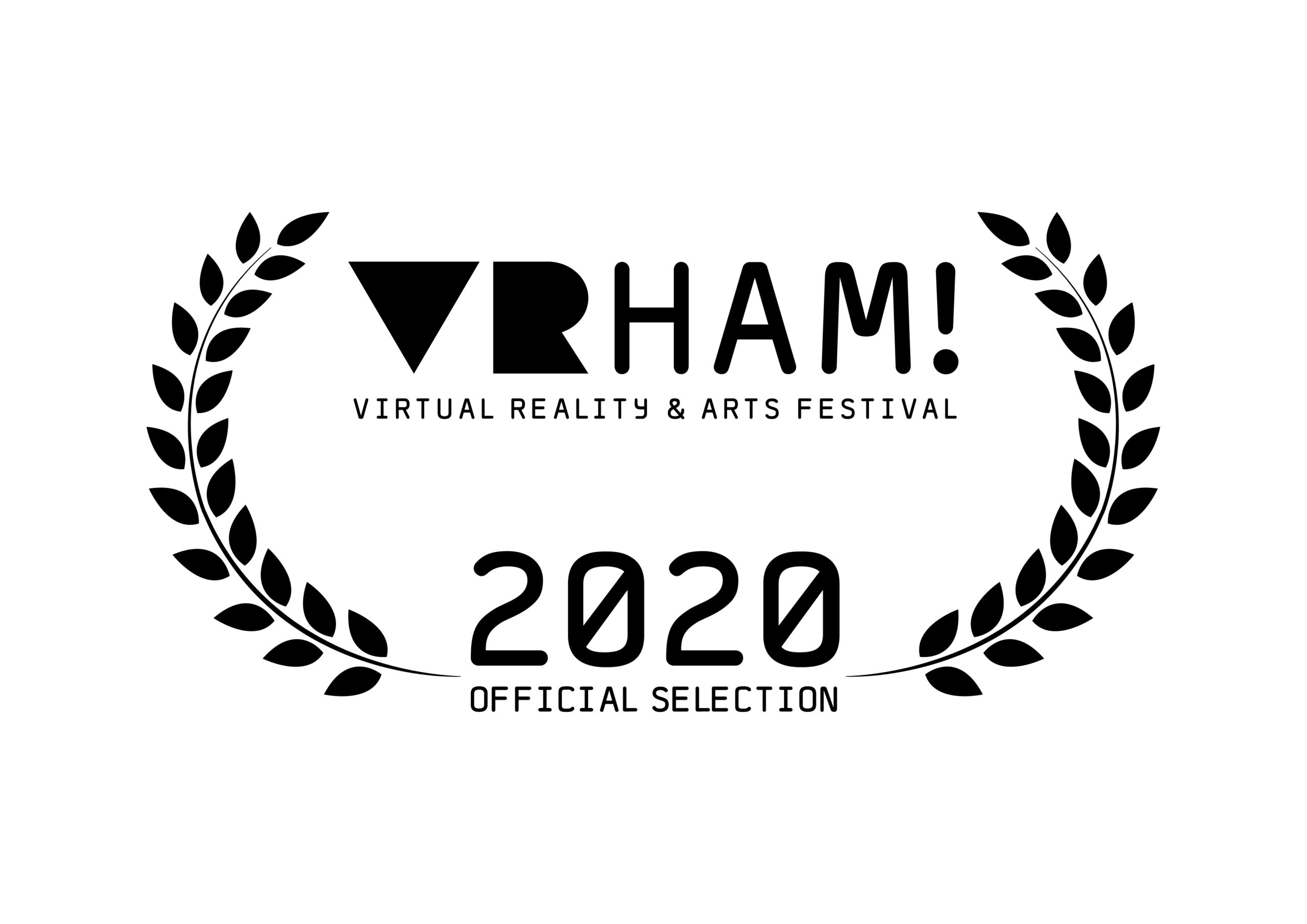
THE KVETNY GALAXY III 2019
Trailer 2019
Ida Kvetny
Words:
Ida Marie Hede
Speaker:
Grete Tulinius
Music by:
La Fontaine d’Arethuse, Mythica: Works for Violin and Piano- Benedikte Damgaard & Emil Gryesten
PLATFORM
HTC Vive and Oculus lus Rift & Quest
Duration:
6 min
Credits:
Made in Unity
THE KVETNY GALAXY III 2019
This artwork is a collaboration between an author ( Ida Marie Hede) and artist (Ida Kvetny). The author has written a text inspired by the artist’s work, where after the artist again has created a new digital work inspired by the words.
The Kvetny Galaxy III unfolds a “Surreal Universe”. The dense dazzled scenario feels, right out of a dystopian magical tale. 3D scanned ceramic sculptures, VR-sculpted animations and classical music lead you by the words into the galaxy. The psychedelic scenes are warped and dreamlike and dripping with saturated colors. There’s a dark feel and an open composition with amoebic creators with transparent souls. The landscape is strange and salute the metaverse. Meanwhile, the floating forms and deep blues call to mind Chagall. With an inspiration by Freud the viewer becomes an conduction archaeologist of the mind. Who attempts to uncover buried thoughts and feelings, to place them in context, to try to understand the relationships between them. The Kvetny Galaxy II looks something like an archaeologist’s lab turned upside down, with strange, unidentifiable organisms and artifacts left and right. Using an “ancient language that transcends time, place, and culture,” the nightmarish landscapes provoke thought and wonder and dread. Philosophical and artistic influences aside, this dark world is a way to connect the digital and the analogue world.
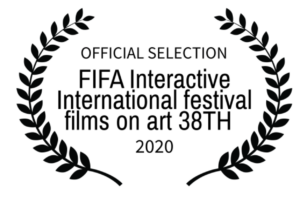
The Kvetny dark of night encloses the city. City lights flare. A fluttering activity begins in the small civilization. No one knows the origin of each object, but the place is filled with things. What things? How did they get here? The treetops murmur and whine glitteringly in silver, they want to answer, the trees begin to stutter a slow tale of creation:
In the dawn of time – no, at once – the Kvetny Organism came into life – she grew out of nothing, or maybe out of a wormhole or a thought . Now she was bald, now she coquettishly flicked her hair. Then she resembled a woman, and then an atmosphere.
A soft, upholstered sleeping mask appeared and covered the Kvetny organism’s half closed eyes. Her hands suddenly moved on their own and grabbed the small controllers. Thus, an aura of wild authority manifested itself in and around the Kvetny organism. She enjoyed pulling the controllers and listening to the low pulse of the machine.
In the calm Kvetny dark of night a circle rotated 360 degrees. It moved in small, angry and tickling thrusts to one, then to the other side across bridges and through passages. She pulled on the controllers, the circle withdrew its eyes. Pixels appeared like buds shooting into the night. No pixels occurred randomly, even though they appeared in a crowd. Each octagonal image comprised a sad heart.
The Kvetny organism woke, threw her hair to one side, then to the other. With the wind in her face she stretched her sculptural body in a flood of mother-of-pearl, twisted her head back and let herself multiply in new bodies. She was fond of many detachable hands and many detachable masks. It was the dark of night’s walk-in closet. Filled with limbs that could float freely. You could put a large finger through the lever in her back. From her glazed, metallic skin, from her DNA and from her eyes and from her rays into the world, she begot everything hallucinatory and all the glittering snakes that were found in humans’ hair and around their arms. The Kvetny organism begot many things. She was athletic and bizarre. She trained like a fury with her chic little kettlebell that had her own image chiseled into it. She allowed it to float through the digital wormholes of the night.
The Kvetny organism whispered-summoned all the things with which she wanted to populate the world: Billboards with 80s kissing mouths. Fighter amazones with aluminum lustre. The mime floated through a Möbius band. She invited everyone who wanted to change their eyes to look through the machine of the upholstered glasses. All the eyes of the city appeared. They looked through the dark of night at the flirting, outdated pictures. The pictures turned to the side and became things of several dimensions. The digital breath of the Kvetny organism had resuscitated every single old drawing in the world and now the drawings recirculated, crowding like small punks, thrown from parallel world to parallel world. They were cracked in precisely the right way. Corny and shimmering of old symbolic and new meanings. It was a great sorrow to the Kvetny organism that surfaces always froze and that pieces of cloth stopped flowing freely in the warm night winds. The brusque monuments barked at her, they were wild and stupid dogs. She left solidified old fathers on their piedestals. She was all in silver. As the organism that she was, she floated everywhere like oxygen and gave high fives to the other floaters.
TEXT
By writer and art arthistorian Ida Marie Hede
GAZE 2019
Director / VR Artwork
Ida Kvetny
Technical assistance
Christopher O`Shea (Real Engine for scenario and lightning)
Music by
La Fontaine d’Arethuse, Mythica: Works for Violin and Piano- Benedikte Damgaard & Emil Gryesten.
The VR work (file) can be viewed via a PC in an Oculus Rift or Htc Vive
GAZE 2019
In the interactive VR art work GAZE, the audience takes on a surreal and virtual art experience, where the oldest art forms such as the sculpture and the painting meet the future of the digital age. Through the work, the audience will be able to challenge the law of gravity andfloatin an inner landscape with recognizable urban elements and 3D scanned ceramic sculptures. The work is based on a kind of new psychedelic revolution with references to surrealism and automatic drawing – now as an experience in four dimensions, where the viewer will be able to move freely inside the work. The VR work is meant to be viewed either alone or in the context of a physical art installation containing a pair of rebuild panorama binoculars, which previously stood on an old tower’s platform in Copenhagen. Now it has been updated for VR and lets the viewer explore an ancient language that transcend times, places and cultures, in this digital age, – a GAZE of phenomena and archetypes at a time when concepts like collective subconsciousness, memory storage and artificial intelligence form a new conception of reality.

